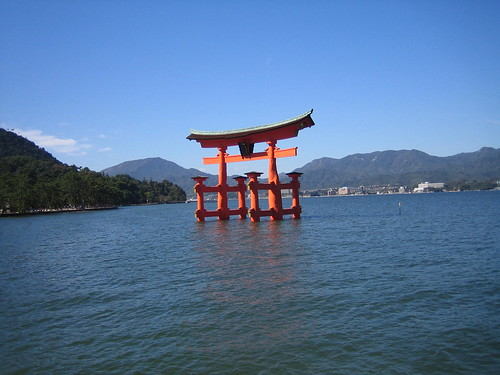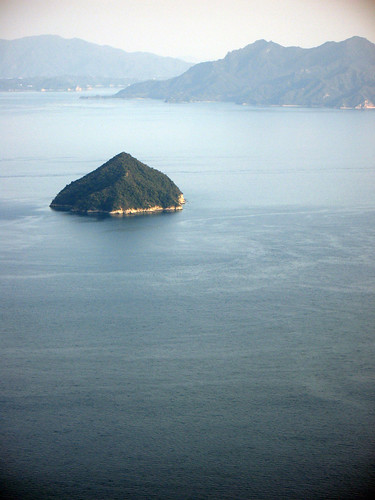Thursday 25th April 2013
On our journey down from Tokyo we’d been a bit worried about the weather – it had been absolutely bucketing down the whole way. Gladly Thursday was a perfect day for wandering around the beautiful island of Miyajima in shorts and t-shirt.
We set off from our hotel, picked up a bit of breakfast and were soon stood on platform 1 waiting for the train bound to Iwakuni. 40 minutes later we got off the train at Miyajima-guchi and headed for the ferries to make the short crossing from the mainland. One of the brilliant things about the JR rail passes is that not only can you travel on shinkansen but you can use any other part of the JR transport network – even their ferries.
As we approached the island we saw the sight which is rated amongst the top 3 views in all of Japan: the floating torii gate of Itsukushama. We’d hoped to get to the island for high tide and although we were a little late we weren’t disappointed and as the ferry passed we had the perfect combination of viewing angle, sunshine and water level to see why people rave about it.

We got off the ferry and walked along the waterfront to Itsukushama-jinja, the shrine which gives the island its true name. This shrine can trace its history back to the 6th century but has been in its current form since 1168. Back then the island’s holy status meant visitors had to approach through the torii gate and disembark onto the shrine’s pier-like construction.
[We got some great photos at this point but because I left my camera on the train we have a single image: the one I instagrammed. Thankfully we only lost one day of pics but I’m still annoyed with myself]
The shrine is the thing for which Miyajima is famous but it’s not a one-trick pony by any means. All the guidebooks recommend spending a night on the island to enjoy a tranquillity that’s hard to find when the island is filled with (mostly Japanese) tourists. Christine and I couldn’t manage it but everybody’s right – you should make a night of it.
We spent the rest of our time on the island enjoying Mount Misen. We chose to take the cable car (ropeway) up to the summit. This journey was in two stages – the first in a small gondola that’s ideal for a few people and the second on an ‘aerial tramway’ that’s much shorter and much larger. It gives brilliant views out over the Seto Inland Sea and of course saves you the effort of making the 530m climb to the top.

The ropeway leaves you with another 20 minutes to get to the top but there’s plenty to see as you’re retracing the final part of Kobo Daishi’s route. He meditated in the temple close to the summit for 100 days following his return from China in the 9th century; the fire that he lit (and which provides the spark for the Flame of Peace in Hiroshima) is said to have been burning without interruption for the past 1200 years.
The walk down the mountain gave another perspective on the island – with several routes to choose from (and most people choosing the comfort of the ropeway to travel in both directions) we were able to enjoy the peace, quiet and shade of the path to the bottom and I don’t think it took that much longer. It was made even better by knowing that we had delicious beef noodles to look forward to once we got down.
With a quick stop off to admire a five storey pagoda we headed back to the ferry. By this point the tide had gone out and the torii was no longer floating but surrounded by people who had walked out on the sand to get a closer look – once the torii was no longer floating and people could walk out to it it seemed to lose something of the reverence and majesty it had had that morning.
We had planned to spend the rest of the day around the Hiroshima Peace Memorial Park but as we stepped off the tram I realised I’d lost the camera. We hurried back to the station and found friendly, helpful staff who tried various different avenues of enquiry but unfortunately we didn’t manage to track it down. We replaced it with something fairly cheap but by that point we’d lost the rest of the day.
The day did end on a positive note though, with the discovery of Okonomyaki but more of that another time.
Daily distance travelled: 32km
Total distance travelled: 10,283km

